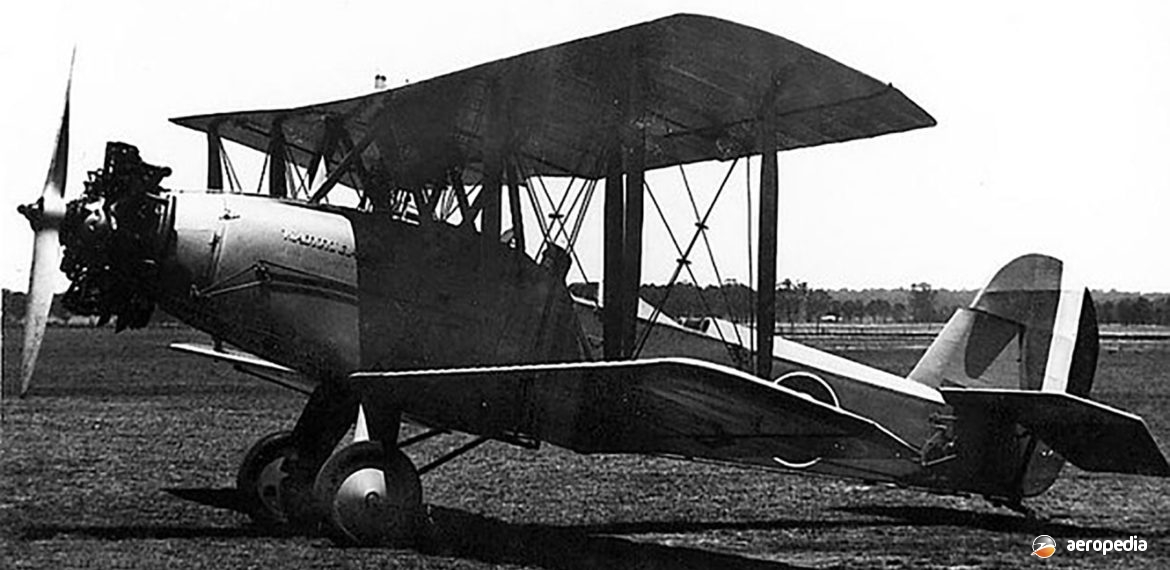Photograph:
Wackett Warrigal II at RAAF Point Cook, VIC in 1930 (RAAF Museum)
Country of origin:
Australia
Description:
Two-seat general purpose/reconnaissance aircraft
Power Plant:
One 336 kw (450 hp) Armstrong Siddeley Jaguar IV nine-cylinder air-cooled radial engine
Specifications:
- Wingspan: 11.357 m (37 ft 3 1/8 in)
- Length [landplane]: 8.204 m (26 ft 11 in)
- Length [floatplane]: 9.474 m (31 ft 1 in)
- Max speed at sea level: 193 km/h (120 mph)
- Max speed at 1,219 m (4,000 ft): 169 km/h (105 mph)
- Max speed at 2,438 m (8,000 ft): 155 km/h (96 mph)
- Best climb speed: 105 km/h (65 mph)
- Best gliding speed: 113 km/h (70 mph)
- Empty weight: 1,095 kg (2,414 lb)
- Loaded weight: 1,659 kg (3,647 lb)
Armament:
One 7.7 mm (0.303 in) Vickers machine gun
History:
The Warrigal II (Warrigal being aboriginal for untamed) was a development of the Warrigal I, and was also built at the RAAF Experimental Section at Randwick, NSW. It featured many of the design features of the earlier machine, and included some improvements gained as a result of the testing and experience with the earlier aircraft. However, by the time the prototype was under construction it had been decided to close the Experimental Section and this lead to delays in its completion.
The Commonwealth Shipping Board sought to transfer the Section to the Cockatoo Island Dockyard in Sydney Harbour, NSW and the Air Board decided to keep the unit open until the Warrigal was completed and then close. After completion it was to be conveyed to No 3 Squadron Richmond, NSW by road for testing. Early drawings showed the fin and rudder to be the same as the Warrigal I but when completed they were somewhat changed. The Warrigal II was slightly larger and when completed had red, white and blue stripes on the rudder.
The Warrigal II was flown for the first time on 7 July 1930 by Flg Off R H Simms who, after testing, said the aircraft was very easy to fly with no peculiarities. On 29 July Flg Off T W Shortridge of the RAAF Reserve was taking off from Mascot, NSW when the engine failed and he was forced to make a cross-wind landing. The machine stalled from 6.1 m (20 ft), extensively damaging the undercarriage, and the aircraft slewed around damaging the mainplanes and the fuselage. The aircraft was conveyed to Cockatoo Island Dockyard for repairs. It was repaired and returned to the Squadron on 12 September, being flown by Flg Off Walter and Cpl Eddison to Point Cook, VIC in 5 hrs 5 mins.
Some further work was necessary. On 24 August 1931 it was given an air test and delivered to the fighter squadron, Flt Lt F R Scherger commencing service trials on 21 September. Further tests were conducted by Flg Off R H Simms. He reported the machine was unpleasant to fly due to excessive torque, an ineffective rudder, and lack of fore and aft stability. Comparisons were made with the Westland Wapiti. Chief of the Air Staff, Richard Williams (later Sir) had hoped, if testing was successful, it would be fitted with a Bristol Jupiter engine and would eventually be built in numbers for the RAAF for army co-operation duties.
On 6 October 1931 it suffered another accident when, on landing at Point Cook, there was a structural failure of the beam to which the undercarriage was attached, and repairs had to be effected. Further tests were conducted on 8 August 1932 and the aircraft was delivered to the Seaplane Squadron on 15 September. Here it was found initially to meet requirements but the fin area needed to be enlarged. Only a small amount of testing was performed and reports stated it would be a valuable aircraft for bay patrols duty, and also for dual instruction when the sea was too rough for the de Havilland DH.60 floatplanes.
In February 1933 the Air Member for Supply stated ”I find the history of this machine has been a succession of crashes and modifications due to structural failure or faults”. By this time the aircraft had accumulated 30 hrs 20 mins as a landplane and 6 hrs 55 mins as a floatplane. In March 1933 it was recommended to be disposed of and a Wapiti with floats be obtained as a replacement. Development of the design was officially stopped on 6 July 1933 and the aircraft retired. In September the airframe was transferred to the Melbourne Technical College, VIC to be used as a training aid and the engine was sold to New England Airways.
A development of the Warrigal which was in planning stages was the Waterhen, which was similar in configuration, powered by the Bristol Jupiter radial engine, and was to be fitted with wheels, floats, or amphibious floats. It never proceeded past the initial design stages.
A two-seat fighter was also proposed and development of this continued for a period, a mock-up of the fuselage being built at Randwick.

